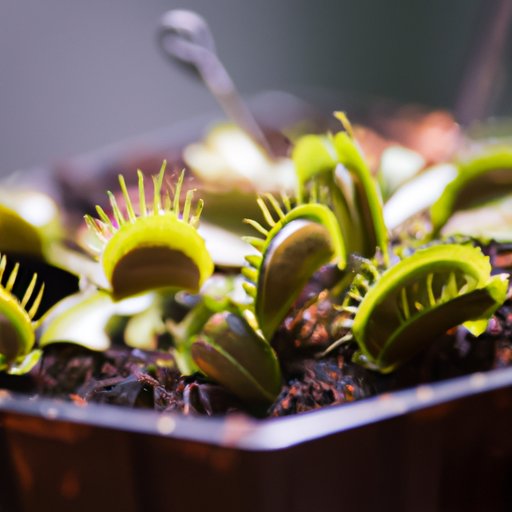
I. Introduction to Venus Fly Traps
Venus Fly Traps are fascinating plants that can capture small insects and bugs with their modified leaves. These unique plants require specific care to thrive and make for an interesting addition to any home or garden.
II. Understanding the Venus Fly Trap
To take proper care of your Venus Fly Trap, it’s essential first to understand the anatomy of the plant. Venus Fly Traps have modified leaves that snap shut when an insect or other small prey lands on them. They then use their digestive enzymes to break down the insect for its nutrients. These plants also rely on photosynthesis for energy like other plants.
Additionally, it’s important to note that Venus Fly Traps have specific watering needs. They are unique in that they don’t need to sit in water as they can absorb moisture from their environment. They should be watered with rainwater and not tap water, which can have minerals that can harm your plant.
III. Soil, Water, and Sunlight
The type of soil you use for your Venus Fly Trap is essential for its health. It’s recommended that you use a combination of sphagnum moss peat and perlite, with a pH between 4.5-5.5. This type of soil will keep the plant’s root system healthy and provide the plant with the nutrients it needs.
In addition to soil, it’s crucial to give your Venus Fly Trap proper watering. As mentioned, these plants do not require constant access to water and can get adequate moisture from their environment. Water your plant using rainwater or distilled water about once a week. Ensure that the soil is moist but not soaking wet, and never let it dry out completely.
Venus Fly Traps require bright and direct sunlight. They should receive at least four hours of direct sunlight each day, as this is crucial for their photosynthesis process.
IV. How to Feed Your Venus Fly Trap
Most Venus Fly Traps don’t need to be fed, as they can capture their prey themselves. However, if you want to provide your plant with extra nutrients, you can feed it small insects such as fruit flies, house flies, and mosquitoes.
It’s essential to prepare the food correctly to prevent harming the plant. To feed your Venus Fly Trap, choose an insect that is approximately one-third the size of the trap. Gently place it inside the trap and avoid touching the trigger hairs to prevent accidentally triggering the trap.
V. Looking for Signs of Good Health
It’s important to inspect your Venus Fly Trap regularly to ensure it’s healthy. Signs of a healthy Venus Fly Trap include bright green leaves and traps that are snapping shut within seconds of being triggered. Additionally, the plant should be producing new growth regularly.
However, it’s essential to note that Venus Fly Traps do have periods of dormancy. During this time, the plant may appear to be wilting, but it’s essential to continue maintaining proper care for the plant during this phase.
VI. Common Problems & Their Solutions
Venus Fly Traps can face several problems that can disrupt their health. One common issue is pests such as spider mites and aphids. These pests can be treated with insecticidal soap or a mixture of water and mild soap.
Additionally, Venus Fly Traps can face common infections such as fungal infection or root rot. Treat these issues by using fungicide, repotting the plant and removing any affected leaves or traps.
Venus Fly Traps can also experience weather-related stress, such as overheating or lack of sunlight during the winter months. To prevent this stress, ensure your plant is placed in a location that gets direct sunlight and has proper ventilation.
If you notice any issues with your Venus Fly Trap, it’s essential to catch them early and take action promptly to prevent the problem from worsening.
VII. Conclusion
Caring for a Venus Fly Trap takes attention to detail and knowledge of its specific care requirements. By following this comprehensive guide, you can ensure that your plant thrives in a healthy environment.




